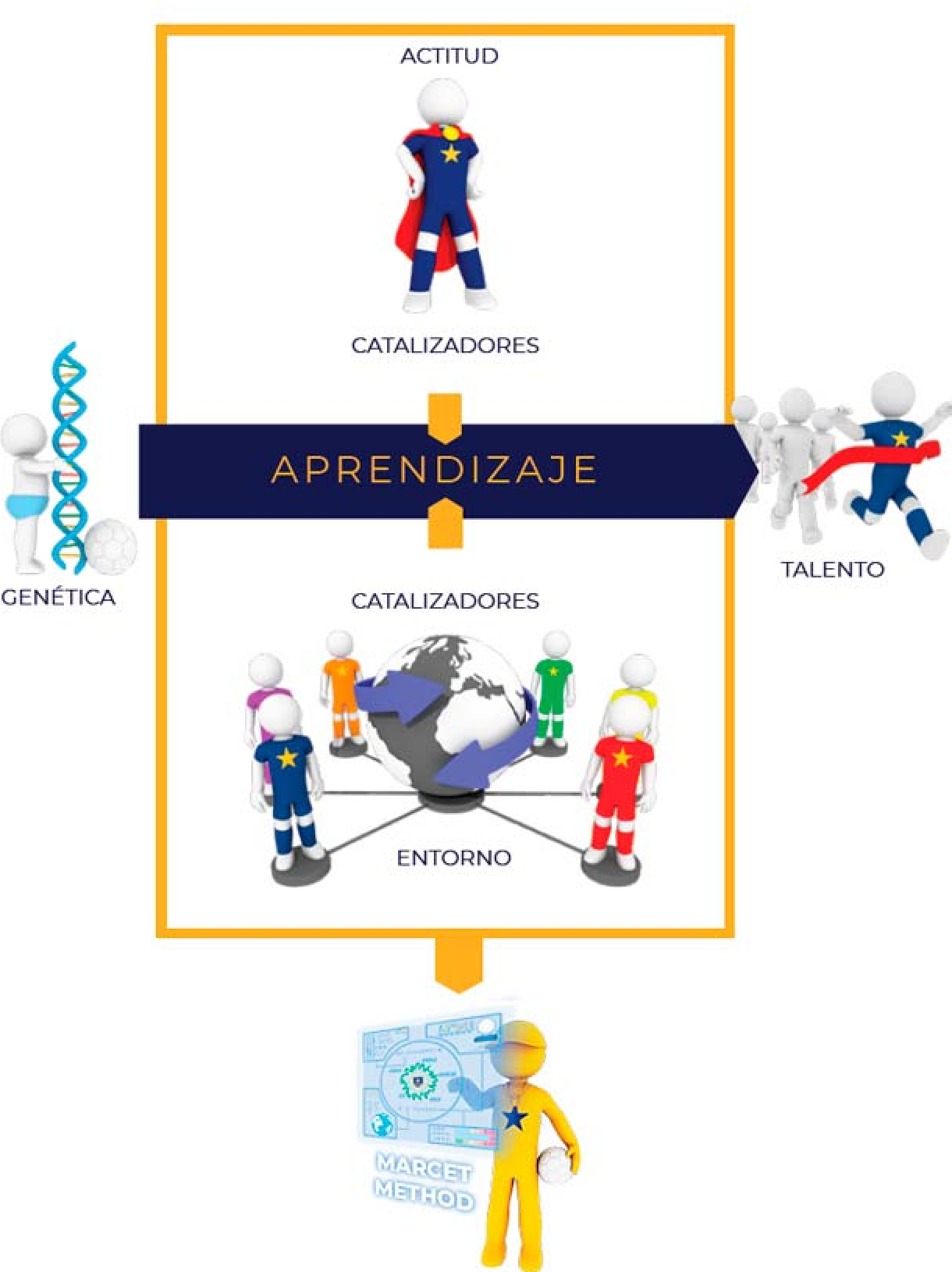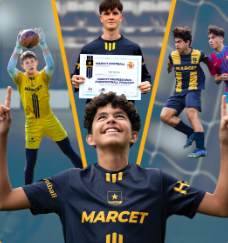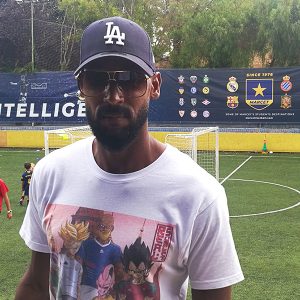Pedagogical Model
The Marcet Football Pedagogical Model is a cognitive process based on Neuroscience
At Marcet, we ensure that our students reach their maximum potential by motivating them to understand the game of football in all its aspects and to play intelligently, with the ability to see, understand, decide, and execute effectively and quickly. But how do we develop these skills?

Talent is not a gift of genetics, but a conquest of effort.
To find talent, we must not look at the beginning, but at the end of the process. Skills emerge and develop as a consequence of exposing genetic capabilities (innate gifts for football) to training, practice, and intelligent learning, taking into account how much the catalysts—positive or negative—that accelerate or inhibit the process of acquiring skills influence.
There are external catalysts, such as the player's environment, family, or country of origin. And there are internal catalysts, that is, intrapersonal ones. It's about the student's awareness of their strengths and weaknesses, and their ability to see themselves realistically: Who am I? How am I? What do I want? Emotional intelligence, positive attitude, self-esteem, and values come into play here.
To channel all these elements towards the development of talent, a pedagogical model focused on the student is needed. Therefore, Marcet teachers do not teach, but rather illuminate the player so that they can reach their own conclusions and learn for themselves. In other words, the student has to learn to learn (metacognition), since in their process towards talent, they will not always be able to have a teacher by their side. Any action in which they are involved (matches, training, life experiences) helps them to progress on their path towards their maximum potential.
The Marcet Method is a cognitive process based on neuroscience and consists of 11 steps
1. Identification
Identify the competencies, knowledge, attitudes, and values that, within 10 years, will be demanded by sports directors and leaders of professional clubs in the best leagues in Western Europe to hire them. This identification is the result of ongoing work, which is constantly updated as substantial changes in the researched reality are identified.

2. Weighting
We determine for each of the identified competencies, knowledge, capabilities, and values a specific weight in relation to the specialty and position on the field of each player.
3. Breakdown
To facilitate learning and evaluation, the identified competencies, knowledge, and values are broken down and dissected into very concrete and detailed behaviors, so that the teacher and the evaluator only have to verify if the student does something or not and to what degree of intensity (never, sometimes, often, and always).
4. Initial Matrix Evaluation
Initial Matrix evaluation that determines the real situation and level of the player in each of the competencies, knowledge, aptitudes, and values in their learning process.
5. Determination of personalized objectives
Determination of personalized objectives for each player, jointly deciding (student-teacher) what competencies, knowledge, skills, and values we want to improve and acquire for each specific student.

6. Personalized learning strategies
How and when to get the student to achieve the set objectives. We program specific training actions and a specific timeframe.
7. Action
The strategy is put into practice through exercises, games, and planned activities.
8. Reaction
We jointly evaluate (teacher-student) the errors that occur during the action to repeat it (reaction) with the appropriate corrections that the players have reached through their own conclusions. Therefore, they act out of conviction, not instruction. Marcet teachers only induce and illuminate. If we find that we are not getting the students to achieve the intended objectives, we will immediately change, and as many times as necessary, the strategies adopted for new ones to adapt to the cognitive process of each specific student.
9. Matrix Evaluation
Once the deadline to achieve an objective has ended, the student is evaluated to see to what degree they have achieved it. When the result is satisfactory, we move on to establish new objectives.
10. Visualize the result
With the Matrix evaluation, players are aware that they are acquiring new knowledge and skills, thus motivating them to continue learning with enthusiasm, perseverance, and a positive attitude. They visualize, clearly, the result of their effort.
11. Determination of new objectives
Teacher and player continually establish new challenges and objectives that the student must achieve. The process is repeated in each training action. It is the circle of excellence.
1. Identification
Identify the competencies, knowledge, attitudes, and values that, within 10 years, will be demanded by sports directors and leaders of professional clubs in the best leagues in Western Europe to hire them. This identification is the result of ongoing work, which is constantly updated as substantial changes in the researched reality are identified.

2. Weighting
We determine for each of the identified competencies, knowledge, capabilities, and values a specific weight in relation to the specialty and position on the field of each player.
3. Breakdown
To facilitate learning and evaluation, the identified competencies, knowledge, and values are broken down and dissected into very concrete and detailed behaviors, so that the teacher and the evaluator only have to verify if the student does something or not and to what degree of intensity (never, sometimes, often, and always).
4. Initial Matrix Evaluation
Initial Matrix evaluation that determines the real situation and level of the player in each of the competencies, knowledge, aptitudes, and values in their learning process.
5. Determination of personalized objectives
Determination of personalized objectives for each player, jointly deciding (student-teacher) what competencies, knowledge, skills, and values we want to improve and acquire for each specific student.

6. Personalized learning strategies
How and when to get the student to achieve the set objectives. We program specific training actions and a specific timeframe.
7. Action
The strategy is put into practice through exercises, games, and planned activities.
8. Reaction
We jointly evaluate (teacher-student) the errors that occur during the action to repeat it (reaction) with the appropriate corrections that the players have reached through their own conclusions. Therefore, they act out of conviction, not instruction. Marcet teachers only induce and illuminate. If we find that we are not getting the students to achieve the intended objectives, we will immediately change, and as many times as necessary, the strategies adopted for new ones to adapt to the cognitive process of each specific student.
9. Matrix Evaluation
Once the deadline to achieve an objective has ended, the student is evaluated to see to what degree they have achieved it. When the result is satisfactory, we move on to establish new objectives.
10. Visualize the result
With the Matrix evaluation, players are aware that they are acquiring new knowledge and skills, thus motivating them to continue learning with enthusiasm, perseverance, and a positive attitude. They visualize, clearly, the result of their effort.
11. Determination of new objectives
Teacher and player continually establish new challenges and objectives that the student must achieve. The process is repeated in each training action. It is the circle of excellence.
What do people say about us?
At Marcet, we take pride in training the future stars of football, combining elite training with a comprehensive education that promotes values such as teamwork, discipline, and respect.

Do you have more questions?
If you have doubts about any of our courses, or you want us to send you more information, fill out the following form, or you can call us:
Do you have more questions?
Check this list of frequently asked questions that we've organized for you



